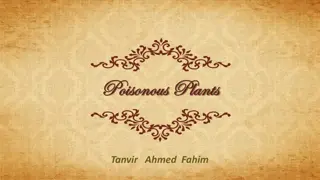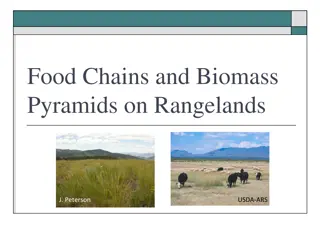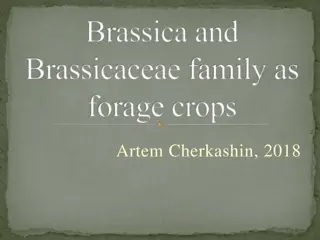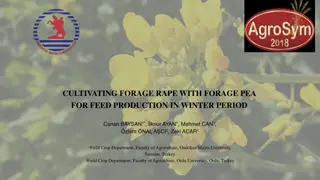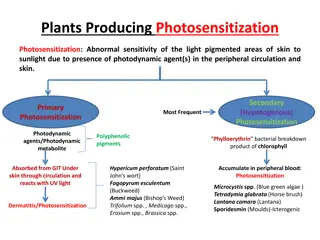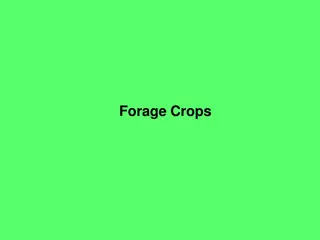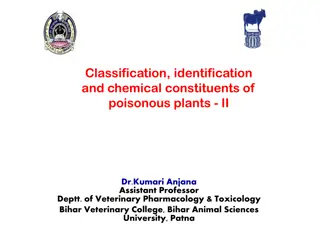Understanding Forage Value and Poisonous Plants in Rangelands
Explore the factors influencing plant nutritive value, such as cell structure, lignification, and anti-quality factors. Learn about the impact of toxic plants on livestock, including death, birth defects, and neurological effects. Discover the types and characteristics of toxic or poisonous plants commonly found in rangelands, emphasizing the importance of identifying and managing them for animal health and land sustainability.
Download Presentation

Please find below an Image/Link to download the presentation.
The content on the website is provided AS IS for your information and personal use only. It may not be sold, licensed, or shared on other websites without obtaining consent from the author. Download presentation by click this link. If you encounter any issues during the download, it is possible that the publisher has removed the file from their server.
E N D
Presentation Transcript
Forage Value & Poisonous Plants Jennifer Peterson RANGELAND PRINCIPLES (REM 151) Jennifer Peterson
Based on the most limiting nutrients on rangelands in the western U.S. Energy Structural carbohydrates (e.g. cellulose) Sugars & Starch Fats (to a limited degree, but important for birds and rodents). Nutrients Protein - Nitrogenous compounds Phosphorus = generally most limiting mineral on rangelands Vitamins = Carotene or Vitamin A
What affects plant nutritive value? 1. Cell structure (Ratio of Cell Wall to Contents) 2. Degree of Lignifications 3. Anti-quality factors
Cell structure: (Wall:Contents) Cell solubles Sugars Starch Organic acids Protein Cell wall Pectin Cellulose Hemicellulose Lignin Cutin Silica
Degree of Lignification Lignin = indigestible portions of cell walls that impregnates cellulose to form wood.
Anti-quality Factors Plants may contain compounds that: Are not digestible Reduce digestibility of nutrients Adversely affect the herbivore Make plants unpalatable More common in forbs and shrubs than grasses
Anti-quality Factors Inhibitors Inhibit or reduced digestion Bind with nutrients to reduce digestibility Kill microbes and inhibiting microbial growth in gut K. Launchbuagh Toxins Affect herbivores directly Cause illness or death Sheri Hagwood - BLM
Toxic or Poisonous Plants What is a toxic plant? Plant that causes negative digestive or physiological effect What effects do toxic plants have? Death Birth Defects (called Teratogenic effects) Reproductive Dysfunction Bloat Dermatitis and Skin Sores Neurological Effects Etc. etc. etc.
Toxic or Poisonous Plants Type Name Longevity Origin Forb Tailcup Lupine Perennial Native Forb Tall Larkspur Perennial Natve
Tailcup Lupine Perennial | Native Raceme Seedhead Palmately Compound Leaves University of Idaho Stillinger Herbarium (http://www.pnwherbaria.org
Tailcup Lupine Perennial | Native Contains alkaloids Nervousness Excessive salivation or frothing at the mouth Reluctance to move about Difficulty breathing Twitching leg muscles Loss of all muscular control Convulsions Some lupines cause birth defects Coma & Death Jennifer Peterson Jennifer Peterson
Tall Larkspur Perennial | Native Raceme Seedhead Purple Flowers Palmately Lobed Leaves University of Idaho Stillinger Herbarium (http://www.pnwherbaria.org
Tall Larkspur Perennial | Native Contains Alkaloids: More livestock die from this plant than any other plant in North America. Symptoms: Nervousness Rapid, irregular pulse Weakness & staggering Animal may fall suddenly Death Excitement and physical exercise intensifies all signs of poisoning Sheri Hagwood, BLM







